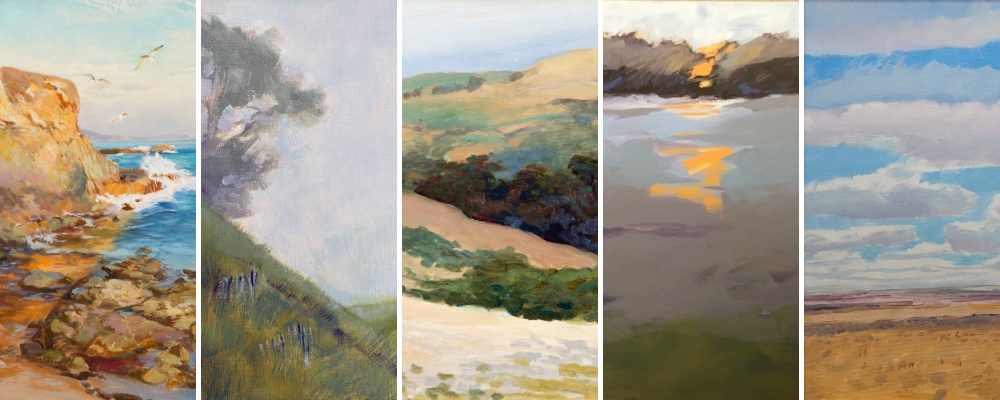Blog
En Plein Air: Painting in the Open Air
August 01, 2023

Images Details (left to right): Fisherman’s Cove at Low Tide, Laguna , Mathias Alten, oil on canvas, ca 1934, 2007.601.1. SweetWater SeaSmoke , Lynne Boezaart, oil on canvas, ca 2016, 2016.76.4. Pompol Beach , Stephen Duren, oil on board, 1999, 2000.056.1m. Reflection Between, Bonnie Palutke, acrylic on canvas, n.d., 2018.79.1. The Plains , Armand Merizon, acrylic on canvas, 1987, 2010.23.2.
"The things that make plein air painting challenging are the same things that make it so interesting and enjoyable. Brushing the snowflakes from your palette; feeling the heat radiate from the sand on the beach; or having a finch light on your easel – those kinds of external elements cannot help but influence the painting in front of you." - Lynne Boezart
While the practice of plein air painting goes back centuries, it was truly French Impressionists, like Claude Monet and Alfred Sisley, who made an art form of leaving behind the four walls of their studio and painting outdoors. En plein air or plein air painting, is the act of painting outdoors. Painting directly with their subject, the landscape around them, artists were more able to capture the changing details of weather and light that happens over the course of a day. Many also felt it allowed for a much more realistic image, versus painting a landscape from photographs or memory. Plein air painting did include several challenges for artists. From animals and bugs to onlookers and environmental conditions precipitation, a number of newly invented tools made the act of painting outdoors much easier for artists.
During the mid-19th century, the ‘box easel’ or ‘field easel’ was invented. While it is uncertain who developed it, the telescopic legs and built in paint box and palette made the easel highly portable. Many designs also had enough room built into the lids to hold wet canvases.
Not only did the outdoors effect conditions for the artist, but also their materials. Artists previously ground each pigment for their paints by hand, carefully mixing the binding oil in proper proportions. After the modern paint tub was invented in 1841 by painter John Goffe Rand, paints could be produced in bulk and sold in tin tubes with a cap. The cap allowed paints to be preserved and contained, allowing flexibility and efficiency to painting outdoors.
Plain air painting has had a resurgence in the past decade, with many artists taking their canvases outside to paint in nature. The local Michigan Plein-Air Painters organization brings artists together to enjoy the challenges and pleasures of painting on location throughout Michigan. Its members encourage each other to step outside the solitary confines of a studio, and to paint and create artwork together outdoors.
The GVSU Art Gallery has several works of art in the collection that were created by artists who worked en plein air, accurately capturing the likeness of the landscapes they surrounded themselves in.
Mathias Alten
German-born American Impressionist Mathias Joseph Alten, is
regarded as one of the most celebrated regionalist artists to have
worked in the United States. Based in Grand Rapids, Michigan, Alten
created more than 3,000 works of art during his prolific career
including landscapes, seascapes, portraits, florals, and still lifes.
Working in a traditional representational style, Alten incorporated
the aesthetics and techniques of the Impressionist Movement into
paintings infused with light and punctuated with deft brushwork. He
could be found both painting in his studio, as well as en plein air
around Michigan and everywhere he traveled.
To see more works of art by Mathias Alten in the collection visit: https://artgallery.gvsu.edu/Detail/entities/637
Lynne Boezaart
Lynne Boezaart has studied with various West Michigan artists,
taking classes and workshops whenever she can. In 2012, she joined a
group of artists to paint en plein air. While painting outside
presents its challenges, such as the weather and insects, Boezaart now
paints in plein air almost exclusively.
To learn more about this work of art by Lynne Boezaart visit: https://artgallery.gvsu.edu/Detail/objects/15565
Stephen Duren
Michigan artist Stephen Duren attended the San Francisco Art
Institute in the 1970s but skipped many of his studio classes in favor
of working outside. During these periods of plein air painting he
observed countless textures and patterns from the landscape. This
visual vocabulary became the foundation for his painting, as his
personal style moved from realism to abstraction.
To see more works of art by Stephen Duren in the collection visit: https://artgallery.gvsu.edu/Detail/entities/352
Bonnie Palutke
Bonnie Palutke’s artwork focuses on the fluidity of paint and
mark making, capturing the emotion of any given moment in brilliant
hues and colors. She frequently directly outside in the elements when
painting her landscapes. A loose brush stroke and speed of execution
are often required to complete a painting while outdoors, working
against time, and daylight, to translate a certain atmospheric feeling.
To learn more about this work of art by Bonnie Palutke visit: https://artgallery.gvsu.edu/Detail/objects/18153
Armand Merizon
As a boy growing up in Grand Rapids, Michigan, Armand Merizon
lived through the Great Depression, joined the military during World
War II, and studied art in New York and Europe. He was a visionary who
experienced the world at-large to be both his most suited classroom
and greatest teacher. Merizon was an artist who refused to be held to
any one style or template for how art should be represented. He threw
off the mantle of tradition and perfected his own style, adding bright
colors, abstract patterns, and textures to even the most common of landscapes.
To see more works of art by Armand Merizon in the collection visit: https://artgallery.gvsu.edu/Detail/entities/339
